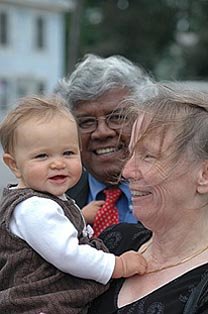Good Morning,
I have borrowed the teaching on Passover and Communion from the presentations by our friend, Rabbi Ron Goldberg. He will be leading the Seder service this evening at 7 p.m. in our church .
This day, Maundy Thursday, (also "Holy Thursday" or "Shire Thursday"1) commemorates Christ's Last Supper and the initiation of the The Lord's Supper. Its name of "Maundy" comes from the Latin word mandatum, meaning "command." This stems from Christ's words in John 13:34, "A new commandment I give unto you." Today we remember the events that occurred on Thursday of what the church calls Holy Week, the last week in the life of Jesus.
It has been estimated that about a third of all the events that we have recorded in Scripture about Jesus’ life occurred during this week.
On that Thursday, the disciples gathered in a home, (whose we are not sure), that had a furnished second floor. Tradition has it that it was the house of John Mark’s mother. (John Mark is the author of Mark’s Gospel). As they gathered, they were taking part in the Seder meal, one of the highlights of the Passover week. The Passover festival was ingrained in the life of the Jewish nation. It commemorated that time when the Jews were enslaved in Egypt. Moses had warned Pharaoh to let his people go, but Pharaoh refused. So God sent one plague after another. Pharaoh wasn’t moved until God sent the tenth and final plague, the death of the firstborns in Egypt. However, this death passed over the homes of the Jews in Goshen as long as the blood of a lamb was sprinkled on the doorposts.
Thus, the feast of Passover was ordered by God as a commemoration of the Jewish nation’s deliverance by God. The meal itself was a symbolic one reminding the Jews of the sufferings of their forefathers and the power of God’s deliverance.
The foods that were eaten were symbols to remind the Jews of their captivity in Egypt. The elements of the Seder include:
1. Lamb The word ’pesach’ (pasch, passover) applies to the Lamb of sacrifice as well as to the deliverance from Egypt and to the feast itself.
2. Unleavened bread (Matzoh) called the "bread of affliction" because it recalls the unleavened bread prepared for the hasty flight by night from Egypt. Three large matzohs are broken and consumed during the ceremony.
3. Bitter herbs (Moror) is a reminder of the bitterness of slavery and suffering in Egypt.
4. Green herbs to be dipped in salt water. Salt water represents tears of sorrow shed during the captivity of the Lord’s people.
5. Haroseth (or ’haroses’) - a mixture of chopped apples, nuts, cinnamon and wine represents the mortar used by Jews in building palaces and pyramids of Egypt during their slavery.
6. Wine is dipped from a common bowl.
There are four acts of drinking wine during the Seder feast – known as the ’Four Cups”. They are the cups of Thanksgiving, Hagadah (’telling’), Blessing, and
Melchisedek (’righteousness’).
It was this Seder Meal that Jesus and the disciples were celebrating in the upper room that night. It was at the conclusion of that meal that Jesus himself gave two of the symbols of the Seder meal fresh significance. He took a loaf and broke it and gave it to his disciples saying:"Take eat, this is my body which is broken for you, do this in remembrance of me." Then he took a cup with wine. He drank from it and gave it to his disciples saying, “Drink ye all of this, for this is my blood which is shed for you and for many for the forgiveness of sin.” And, of course, from this was born the Sacrament of the Holy Communion. It is significant hat Jesus took the elements for the Holy Communion from the Passover festival because, in Passover, the children of God celebrated God’s Salvation, which resulted in the Israelites being released from the slavery of Egypt
In Holy Communion we, the children of God, celebrate God’s salvation through Jesus’ death on the Cross. Indeed, the salvation Jesus offers has resulted in all mankind having the capability of being freed from the slavery of sin. In other words, the first Passover is an Old Testament prefiguring of Jesus’ vicarious death of the Cross – the Salvation of God. So it was highly significant that Jesus died at Passover, for it reminds us of what God has done through Jesus.
As St. John put it, 3:16"For God so loved the world that he gave his one and only Son, that whoever believes in him shall not perish but have eternal life." Or, as St. Paul puts it, "But God demonstrates his own love for us in this: While we were still sinners, Christ died for us."
So today, let us give thanks for that wonderful gift of God – our salvation – eternal life that cost Jesus dearly, as we recall tomorrow on Good Friday. And let us remember too that Christ gave his Church just one command: "A new command I give you: Love one another. As I have loved you, so you must love one another. By this all men will know that you are my disciples, if you love one another."
Jesus give us the motivation to be different. We are called to LOVE. Francis Schaeffer founder of the L’Abri Fellowship said: “Love is the final apologetic” . Tertullian, in the second Century, reported the comments of pagans in his day: “Behold, how these Christians love one another! How they are ready to die for each other!” Their mutual love, Bruce Milne wrote, ”was the magnet which drew pagan multitudes to Christ. It has the potential to do so still.”
In Christ,
Brown
click here to view video
http://www.youtube.com/watch?v=xbMOAzoOP08
Thursday, March 20, 2008
Subscribe to:
Post Comments (Atom)









No comments:
Post a Comment